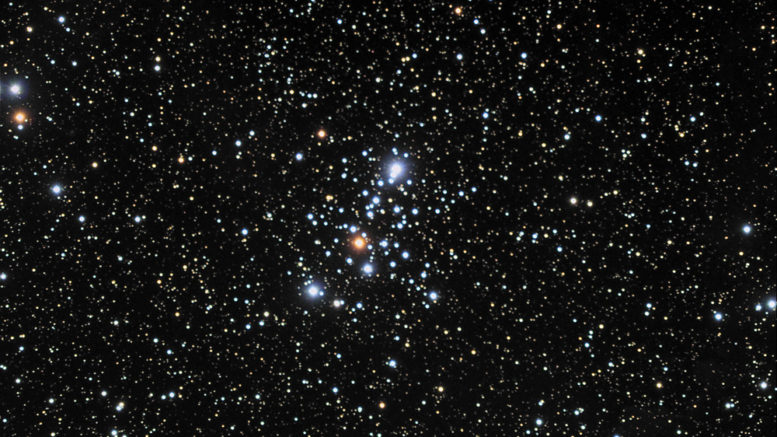Messier 103 is an open star cluster located in the northern constellation Cassiopeia. Messier 103 is one of the smallest and most remote open clusters known, as it contains 172 confirmed members.
| Description | |
| Visible From Pacific Northwest | Anytime of year. Circumpolar, so object never sets |
| Best Time To Observe | October or November |
| Minimum Size Of Viewing Device | Binoculars |
| Object Type | Open Cluster |
| Designations | Messier 103, M103, NGC 581, Collinder 14, C 0129+604, OCISM 75, OCl 326, MWSC 0124 |
| Right Ascension | 01h 33.2m |
| Declination | +60°42′ |
| Constellation | Cassiopia |
| Age | 25 Million Years Old |
| Apparent magnitude | +7.4 |
| Apparent dimensions | 6′ |
| Object Radius | 8.75 light years |
| Distance From Earth | 10,000 light years |
History
Messier 103 was discovered by the French astronomer Pierre Méchain in March or April 1781. Méchain described the object as a “cluster of stars between Epsilon & Delta of the leg of Cassiopeia.”
M103 was one of the last minute additions to the Messier Catalogue. Messier did not get a chance to observe and verify Méchain’s three discoveries before publication. M103 was the last object to be entered by Messier himself.
Swedish astronomer Åke Wallenquist identified 40 member stars in the cluster and Czech astronomer Antonín Bečvář added about 20 more stars to the list. Brent A. Archinal and Steven J. Hynes (Star Clusters, 2003) identified a total of 172 members. Harlow Shapley classified M103 as type d, a loose and poorly populated open cluster
Locating M103 In The Sky
Messier 103 is easy to find because it lies within Cassiopeia’s familiar W shape. It can be located 1 degree east of Ruchbah, Delta Cassiopeiae, the bottom left star of the W. It lies near the line connecting Ruchbah and Segin, Epsilon Cassiopeiae, the upper left star of the W. The best time of year to observe M103 is during the winter, but northern observers can see it at any time of year. The cluster is circumpolar and never sets below the horizon north of latitude 30N.

Viewing M103
It is easy to see, even with binoculars, and appears as a nebulous fan-shaped patch. 4-inch telescopes resolve the four brightest stars in the cluster. Large telescopes resolve more stars across the cluster, but make it harder to make out M103 from the surrounding star field because the cluster is quite loose.
Photographing M103
Imaging of Messier 103 should be done with luminance, red, blue, and green filters, regardless of the camera type. This will really bring out the colors in the cluster. Accurate guiding is crucial as it will allow the stars to remain crisp. Several hours of exposure data can be used to make the final image, but there have been some really great images produced that only utilize about 30 to 45 minutes of exposure. It is ideal to utilize several hours of exposure with a larger telescope for this object, and there are a plethora of others who can provide inspiration for the gear they used, which can be scaled to your specific setup.
Sources And Further Reading
Descriptions of all of Messier Objects can be found here.
https://freestarcharts.com/messier-103
https://www.messier.seds.org/m/m103.html
https://www.galactic-hunter.com/post/_m103

Be the first to comment on "Messier 103"